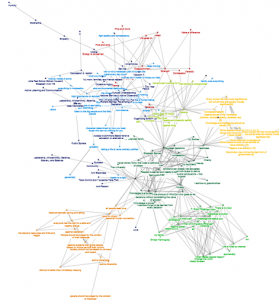There have traditionally been two families of answers to the question: How can a moral belief be justified? Foundationalists think that beliefs are justified if they follow from beliefs that are somehow “foundational.” As Geoffrey Sayre-McCord writes, “traditionally, foundational beliefs have been credited with all sorts of wonderful properties, with being, for instance, infallible, or indubitable, or incorrigible, or certain” (p. 154). Foundational beliefs are also frequently assumed to be big: very general in scope and application. So the belief that all humans are created equal may be considered a worthy candidate to be foundational. Skepticism about foundationalism usually takes the form of asking: How can you tell that such beliefs are true? What justifies them?
Sayre-McCord divides the turf a bit differently, so that a foundationalist is simply someone who holds that some moral beliefs have a special status. They are “privileged.” They may nevertheless be fallible and modest in scope. They may, for example, be concrete judgments that we draw from experience. But they are privileged because their justification is not the support that they receive from other moral reasons. A foundationalist thinks that a given moral belief is justified only if it is foundational or it follows from foundational beliefs.
Coherentists say, instead, that all moral beliefs are on par. There is no privileged class. Any moral belief is justified by the other beliefs that relate to it. The reasons we give for a belief take the form of connections to other beliefs. By the way, the fact that a moral worldview (such as utilitarianism, or Judaism) coheres is not a reason to hold each of its component beliefs. Rather, the reason for each belief just is the support it gets from other beliefs. The more such support exists, the more we say that the whole coheres (p. 170). But we shouldn’t believe something just because it belongs to some coherent system.
Sayre-McCord writes, “The relative coherence of a set of beliefs is a matter of whether, and to what extent, the set exhibits (what I will call) evidential consistency, connectedness, and comprehensiveness” (p. 166). Evidential consistency could be defined as logical consistency among all the beliefs in the set, but Sayre-McCord prefers the principle that the balance of evidence in the set as a whole should not tell against any of the individual beliefs–that would be an inconsistency. Beyond evidential consistency, but you get more coherence points for having “stronger and more extensive” support among your beliefs (connectedness) and having more beliefs in your set (comprehensiveness) (p. 167).
I am trying to develop a somewhat different model, based on understanding the relations among beliefs as networks rather than sets. A network model has these advantages:
- It reveals much more complex and significant relationships among beliefs than simply whether each belief (A) supports another (B). It reveals characteristics–such as clustering, density, and centralization–that are important features of the whole.
- It avoids privileging consistency. I think morally excellent thinkers often hold ideas that are in fruitful and challenging tension with each other. Better to have a dense and complex network of ideas in which some count against others than a simpler network that is all-too-neatly consistent. Yet we can call the former “coherent” if we define coherence in network terms. Relatedly, the standard methodology of moral improvement is weeding out inconsistencies. I think that method can easily make one’s moral worldview worse. A network model suggests other methodologies, such as identifying beliefs that are central and asking whether they deserve that weight.
- It easily accommodates multiple levels. I have a network of personal beliefs pertinent to a particular topic that explicitly concerns me, such as my children’s school. They fit it a much larger network of other beliefs, some vague and unformed. Other people with whom I talk have their own networks. Our networks influence each other; in fact, mine came from other people and constantly changes as a result of interaction. The coherence of the community’s ideas may be more important than the coherence of my own, but both levels of analysis are worthwhile.
- It makes the difference between foundationalism and coherentism a matter of degree. A belief is relatively foundational to the extent that it supports or even implies a lot of other beliefs but does not have much support from other beliefs. To the degree that a network clusters around such beliefs, it is a foundationalist network. A network in which every belief has roughly equal support from other beliefs is non-foundationalist. We can then ask empirically which kind of network works better for certain important purposes, such as deliberation.
Source: Geoffrey Sayre-McCord, “Coherentist Epistemology and Moral Theory,” in Walter Sinnott-Armstrong and Mark Timmons, eds., Moral Knowledge? New Readings in Moral Epistemology (New York: Oxford, 1996), pp. 137-189.
The post a different take on coherence in ethics appeared first on Peter Levine.


